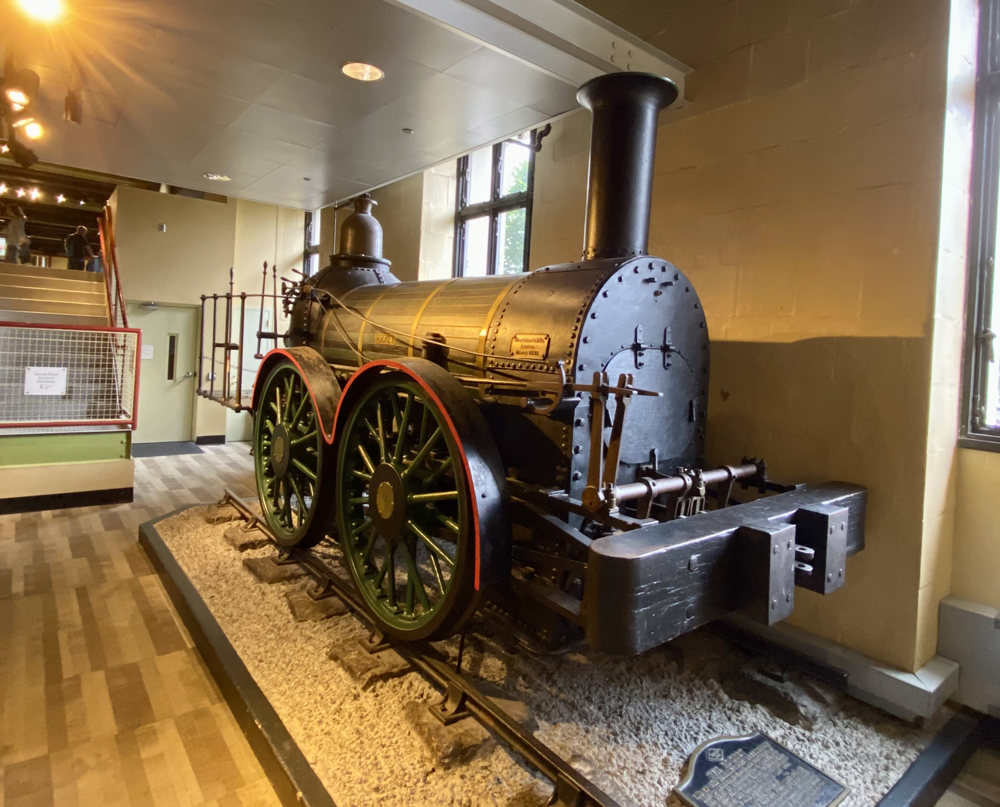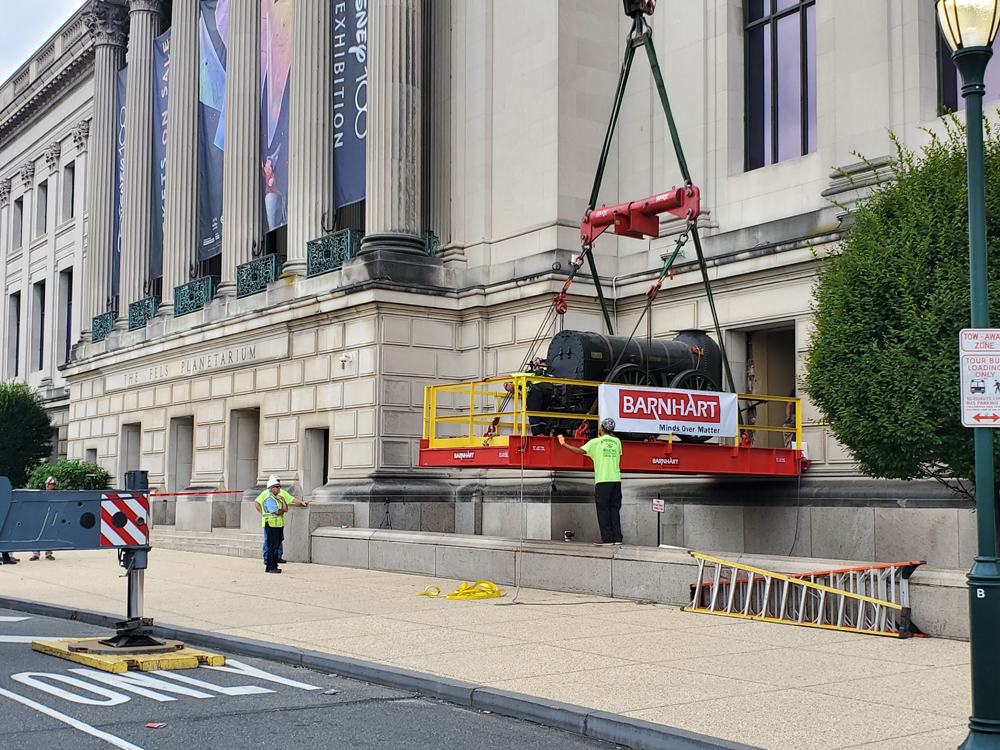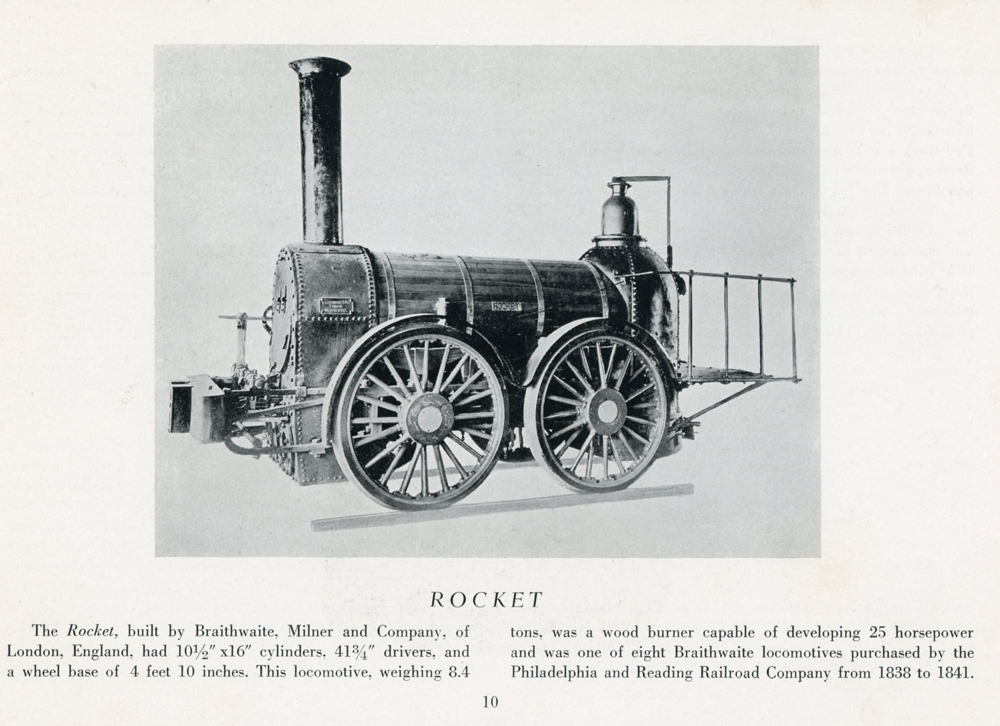
PHILADELPHIA — One of the oldest surviving steam locomotives in North America – also distinguished as the oldest former Reading Railroad engine – is getting a new home, the Railroad Museum of Pennsylvania in Strasburg, Pa.
Imported from England in 1838 for the Philadelphia & Reading Railroad, the 8-1/2-ton, 25-horsepower Rocket recently left its home of the last 90 years at the Franklin Institute.
Built as a wood-burner by Braithwaite, Milner & Co. of London, it was the first of eight engines the Reading acquired from that firm through 1841. Since 1933, it has been exhibited at Philadelphia’s Franklin Institute, where it occupied space next to the 228-ton Baldwin Locomotive Works experimental 4-10-2 engine No. 60,000, built in 1926. As another measure of comparison, Rocket’s 41-inch-diameter driving-wheel measurement is the same size as 60,000’s trailing-truck wheels.
Rocket is an 0-2-2-0 design, as Patrick C. Morrison, director of the railroad museum, points out – the first set of wheels are free-wheeling, with only the second set being powered.
The Franklin Institute is in the midst of a multi-million-dollar makeover of what it had called the Train Factory, funded by the Hamilton Family Charitable Trust, which is headed by heirs of BLW President Samuel M. Vauclain (1856-1940). The space made available by Rocket’s removal will be repurposed to display more of the Institute’s thousands of artifacts.
“Certainly [Rocket is] something that’s been on our wish list for decades,” said Morrison. “It will be the oldest . . . locomotive we own.”
Prior to this, Virginia & Truckee 2-6-0 engine Tahoe (BLW, 1875) was the oldest locomotive, and a Cumberland Valley Railroad combine car from 1855 was the oldest car.
An unlikely owner

While the paperwork is still being made final, the most surprising aspect of all is who owns the locomotive now: Conrail.
In 1933, it was the Reading Co. that placed the engine on long-term loan to the Franklin Institute. The Reading went bankrupt in 1971 and was swept into Conrail in 1976. For some reason, the locomotive didn’t remain with the Reading trustees, but became part of assets conveyed to Conrail. When Conrail was split in 1998 between Norfolk Southern and CSX Transportation, a remnant survived to provide terminal operations in North Jersey, South Jersey/Philly and Detroit. Named Conrail Shared Assets Organization, it is headquartered across the Delaware River from Philadelphia in Mount Laurel, N.J. CSAO ended up with the Rocket.
Morrison said the museum worked with Eric Levin, CSAO vice president-engineering, mechanical & real estate, to make the transfer a reality. Levin has been active in railroad operations and historic preservation all his life. His father is Bennett Levin, longtime preservationist and board member of both the EBT Foundation, Inc., and the Railroaders Memorial Museum in Altoona, Pa.
“It’s an example of how museums and railroads can work together to continue preservation of an important artifact,” Morrison said.
Rocket is a diminutive machine by any modern standard, measuring only 17 feet long, but to enable it to clear the window through which it was extricated, workers removed its stack, steam dome, fenders, and footplate.
Morrison gave high marks to the two rigging companies that handled what he called a “delicate move” on Aug. 5.
“We’ve been working with Mike Venezia of Venezia Enterprises, who assembled a dream team of people to work with,” said Morrison. Franklin Institute’s contractor, Barnhart Crane & Rigging, handled the removal from the building, while the Lancaster, Pa.-based Venezia oversaw loading and transportation.
Morrison said that Venezia is well acquainted with moving historic railroad equipment, noting that “About 17% of our collection was moved in by him.”
Rocket was trucked to what Morrison described as an “undisclosed offsite location to be reassembled.” It’s expected to enter the museum’s George M. Hart Locomotive and Rolling Stock Hall sometime this fall. After final reassembly by the museum’s own shop, it will be displayed for the public, perhaps on the section of original rail with stabilizing chairs on which it sat in Philadelphia.
Noting that the decision to move the engine was a difficult one for Franklin, Morrison said that the transaction represents a “seamless stewardship of historic railroad equipment. . . . in the end, it’s another chapter in the very wonderful story of that locomotive’s history.
Service life
According to a 1941 Reading Co. promotional booklet, Rocket was among Reading’s earliest engines, being delivered to the Port of Philadelphia in March 1838. It traveled by boat on the Schuylkill Canal to Reading, Pa., where it took part in the opening of that part of the Reading in May 1838. Two months later, it first hauled passengers.

Rapid advancements in locomotive design and weight quickly sidelined the engine, which was reassigned in 1845 to work-train service, during which time it gained a covered cab and was converted to burn anthracite coal. In 1865, it became a switcher at Reading, then was reassigned again to the railroad’s Richmond Wharves in Philadelphia. It worked there until it was retired.
In a prepared release, Morrison said: “In March 1879, the Rocket was retired after having traveled 310,164 miles over the course of its career. Following its retirement, the Rocket sat unused and neglected until it was fully restored for exhibition purposes.
“The Rocket was shown at the World’s Columbian Exposition – Chicago World’s Fair – in 1893; the Louisiana Purchase Exposition – St. Louis World’s Fair – in 1904; and the Baltimore & Ohio Railroad’s “Fair of the Iron Horse” in 1927.
“It was placed on public display in 1934. Since that time, it has been displayed on a portion of its original tracks next to the Baldwin 60000 locomotive.“
Technologically, Morrison said, almost uncanny parallels exist between Rocket and the better-known 1831 John Bull, another British-built import that worked for the Camden & Amboy Railroad and is now housed at the Smithsonian Institution’s National Museum of American History in Washington. The museum at Strasburg houses a John Bull replica built by the Pennsylvania Railroad’s Altoona, Pa., shops in 1940 for the New York World’s Fair.
As for Rocket, Morrison said, “It fills a gap quite nicely. From 1838 to the 1981 AEM-7 [Amtrak electric locomotive], there’s 150 years of documented history.”
More on the locomotive, from the Reading Co. Technical & Historical Society, is available here.














‘185-year-old Conrail locomotive moving to Railroad Museum of Pennsylvania’ would be a better title. What an interesting twist to the story!
Hey, where’s the PTC transceiver! 🙂
* REVISED COMMENT *
For beloved “Rocket,” it is time to say farewell to the Franklin Institute and hello to the Railroad Museum of Pennsylvania.
Dr. Güntürk Üstün
For beloved “Rocket,” it is time to say farewell to the Franklin Institute and hello to the Pennsylvania Railroad Museum.
Dr. Güntürk Üstün
The correct name is Railroad Museum of Pennsylvania.
It is a museum of the Commonwealth of Pennsylvania and encompasses ALL the railroads in the Commonwealth.
Indeed, it is a concrete example of how museums and railroads can work together to continue the preservation of an important railway artifact.
Dr. Güntürk Üstün
Samuel Vauclain is probably better known for his four cylinder (over/under) compound locomotives that dominated high-speed railroading in the 1890’s. It turned out that superheat with piston valves produced a simpler (pun intended) route to more powerful operation.
Vauclain worked for Baldwin’s where he was President from 1919 to 1929 and Chairman thereafter. Vauclain had 4-10-2 60,000 built as an experimental locomotive with a watertube firebox (350 psi BP), compound cylinders with the middle high pressure cylinder connected to the second driving axle and timed by a third set of Walschaerts valve gear, outside the driving wheels. 60000 set records for power, operating efficiency and complexity. https://cs.trains.com/ctr/b/mileposts/archive/2019/06/14/baldwin-60000-oddball-in-the-spotlight.aspx